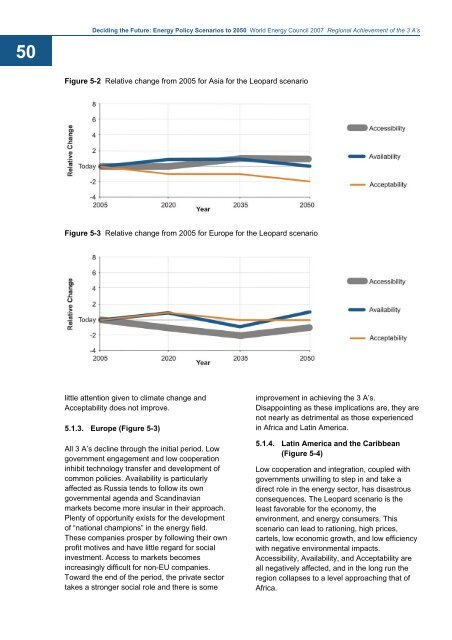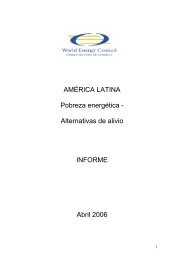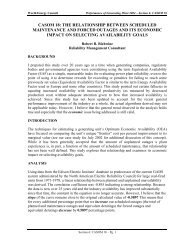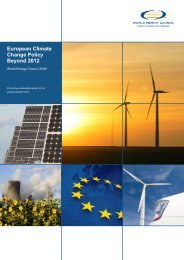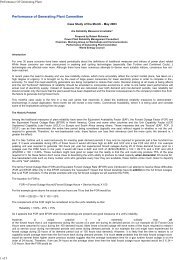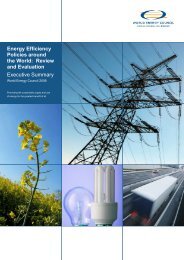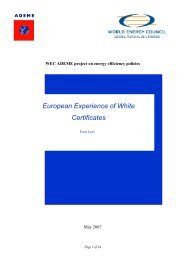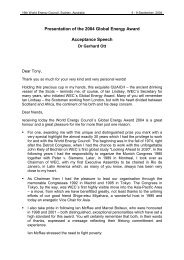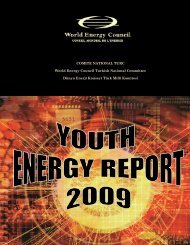Deciding the Future: Energy Policy Scenarios to 2050
Deciding the Future: Energy Policy Scenarios to 2050
Deciding the Future: Energy Policy Scenarios to 2050
Create successful ePaper yourself
Turn your PDF publications into a flip-book with our unique Google optimized e-Paper software.
50<br />
<strong>Deciding</strong> <strong>the</strong> <strong>Future</strong>: <strong>Energy</strong> <strong>Policy</strong> <strong>Scenarios</strong> <strong>to</strong> <strong>2050</strong> World <strong>Energy</strong> Council 2007 Regional Achievement of <strong>the</strong> 3 A’s<br />
Figure 5-2 Relative change from 2005 for Asia for <strong>the</strong> Leopard scenario<br />
Figure 5-3 Relative change from 2005 for Europe for <strong>the</strong> Leopard scenario<br />
little attention given <strong>to</strong> climate change and<br />
Acceptability does not improve.<br />
5.1.3. Europe (Figure 5-3)<br />
All 3 A’s decline through <strong>the</strong> initial period. Low<br />
government engagement and low cooperation<br />
inhibit technology transfer and development of<br />
common policies. Availability is particularly<br />
affected as Russia tends <strong>to</strong> follow its own<br />
governmental agenda and Scandinavian<br />
markets become more insular in <strong>the</strong>ir approach.<br />
Plenty of opportunity exists for <strong>the</strong> development<br />
of “national champions” in <strong>the</strong> energy field.<br />
These companies prosper by following <strong>the</strong>ir own<br />
profit motives and have little regard for social<br />
investment. Access <strong>to</strong> markets becomes<br />
increasingly difficult for non-EU companies.<br />
Toward <strong>the</strong> end of <strong>the</strong> period, <strong>the</strong> private sec<strong>to</strong>r<br />
takes a stronger social role and <strong>the</strong>re is some<br />
improvement in achieving <strong>the</strong> 3 A’s.<br />
Disappointing as <strong>the</strong>se implications are, <strong>the</strong>y are<br />
not nearly as detrimental as those experienced<br />
in Africa and Latin America.<br />
5.1.4. Latin America and <strong>the</strong> Caribbean<br />
(Figure 5-4)<br />
Low cooperation and integration, coupled with<br />
governments unwilling <strong>to</strong> step in and take a<br />
direct role in <strong>the</strong> energy sec<strong>to</strong>r, has disastrous<br />
consequences. The Leopard scenario is <strong>the</strong><br />
least favorable for <strong>the</strong> economy, <strong>the</strong><br />
environment, and energy consumers. This<br />
scenario can lead <strong>to</strong> rationing, high prices,<br />
cartels, low economic growth, and low efficiency<br />
with negative environmental impacts.<br />
Accessibility, Availability, and Acceptability are<br />
all negatively affected, and in <strong>the</strong> long run <strong>the</strong><br />
region collapses <strong>to</strong> a level approaching that of<br />
Africa.


